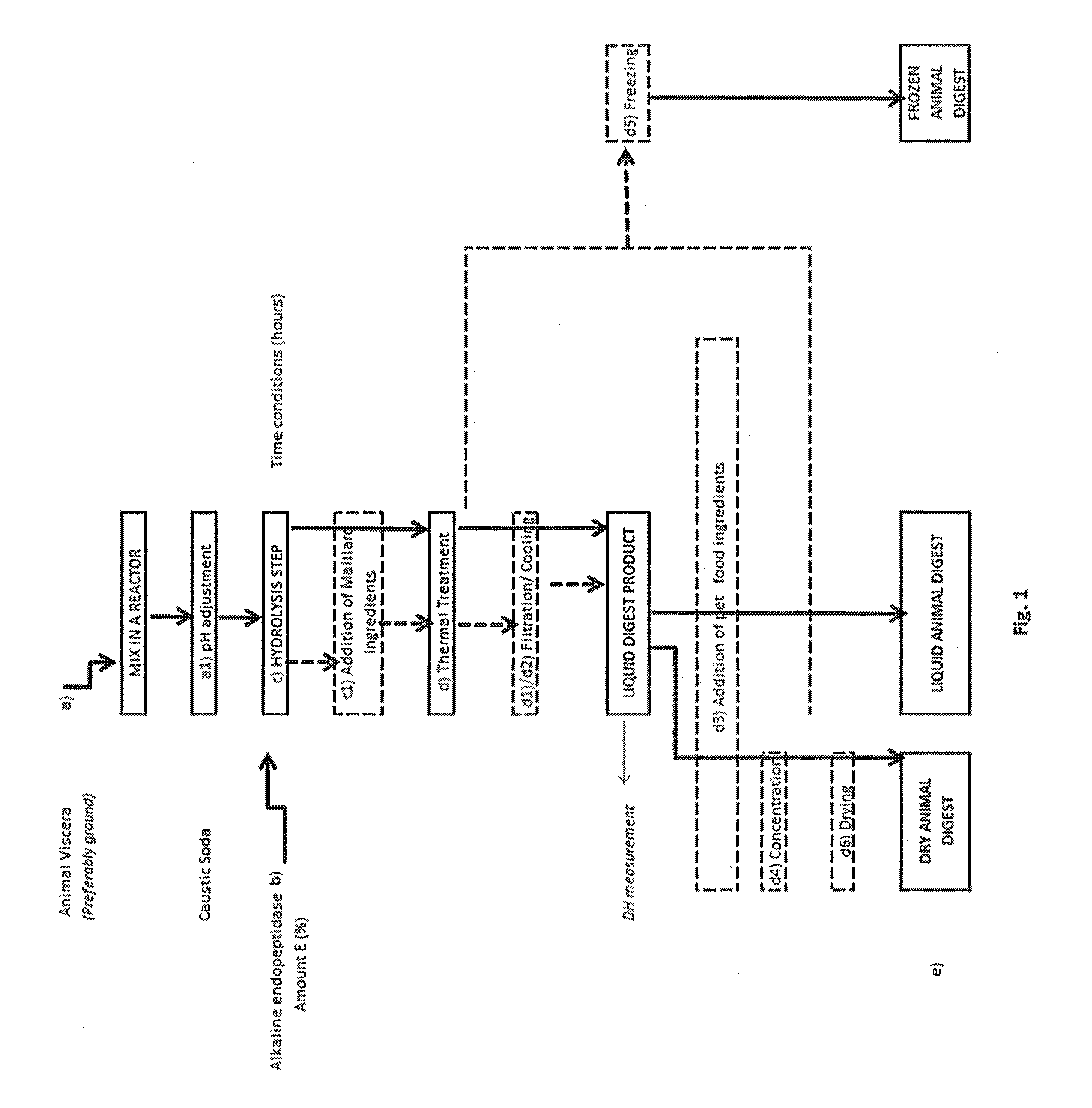Meat tissue digests having enhanced palatability for use in pet food
a technology of enhanced palatability and digests, which is applied in the field of pet food, can solve the problems of reducing chemical stability, increasing osmolarity, and being too high to produce an appropriate digest, and achieves enhanced palatability and enhanced palatability
- Summary
- Abstract
- Description
- Claims
- Application Information
AI Technical Summary
Benefits of technology
Problems solved by technology
Method used
Image
Examples
example 1
[0206]In this example, different dry fish tissue digests were prepared according to different conditions of hydrolysis. All dry fish tissue digests were prepared according to FIG. 1. The formulation of liquid digest product S is described in Table 1 below:
TABLE 1% by weight of liquidFormulation of liquid digest product Sdigest product SWhite fish heads and bones95.28Caustic soda0.5Antioxydants0.130Citric acid0.02Ascorbic acid0.03Maillard Ingredients3.4Enzyme:Alkaline endopeptidase0.64
[0207]Liquid digest product S (“Liq dig pd S”) was prepared as follows. Fresh raw materials (white fish heads and bones) were ground in a vertical cutter for 6 min at a maximum speed. The ground raw materials were transferred to a reactor and mixed with the other ingredients. pH was adjusted at 8.5 with caustic soda, and then enzyme was incorporated. The hydrolysis step was carried at 60° C. for 3 hours. At the end of the hydrolysis step, Maillard ingredients were incorporated. The temperature was gradu...
example 2
[0215]In this example, fish cat food product Y from Example 1 above was compared for palatability to a dry cat food coated with a fish-based dry cat PE of the commercial range SPF C'SENS®.
[0216]The formulation of liquid tissue digest product Y is described in Table 4 below:
TABLE 4% by weight of liquidFormulation of liquid digest product Ydigest product YWhite fish heads and bones95.32Caustic soda0.5Antioxydants0.130Citric acid0.02Ascorbic acid0.03Maillard Ingredients3.4Enzyme:Alkaline endopeptidase0.3
[0217]Liquid tissue digest product Y was prepared as described in Example 1. This liquid was then spray dried at appropriate temperature from 180 to 220° C. for several minutes, in order to remove excess of water. Dry fish tissue digest Y was thus obtained.
[0218]The fish-based liquid tissue digest used to produce dry cat PE of the commercial range SPF C'SENS® was obtained from similar raw material (white fish heads and bones) but the enzyme used for hydrolyzing step is a neutral endopep...
example 3
[0224]Two dry animal digests for cats were manufactured as follows:
[0225]Control Composition 1:
[0226]Formulation is expressed by weight of the liquid digest product.
TABLE 7% by weight of liquidFormulation of liquid digest product 1digest product 1Pork muscle71Water23.87Caustic soda1.472Antioxydants0.142Citric acid0.019Ascorbic acid0.028Maillard Ingredients3.22Enzyme:Neutral endopeptidase0.249
[0227]Fresh raw materials (pork muscle) were ground in a vertical cutter for 10 min with water at a maximum speed. The ground raw materials were transferred to a reactor and mixed with the other ingredients. pH was adjusted to 6.5 with caustic soda, and then enzyme was incorporated. The hydrolysis step was carried at 55° C. for 3 hours. At the end of the hydrolysis step, Maillard ingredients were incorporated. The temperature was gradually increased to 100° C. and maintained during 30 min in order to inactivate the enzyme, to allow Maillard reaction, and thus to develop flavour compounds. A slig...
PUM
 Login to View More
Login to View More Abstract
Description
Claims
Application Information
 Login to View More
Login to View More - R&D
- Intellectual Property
- Life Sciences
- Materials
- Tech Scout
- Unparalleled Data Quality
- Higher Quality Content
- 60% Fewer Hallucinations
Browse by: Latest US Patents, China's latest patents, Technical Efficacy Thesaurus, Application Domain, Technology Topic, Popular Technical Reports.
© 2025 PatSnap. All rights reserved.Legal|Privacy policy|Modern Slavery Act Transparency Statement|Sitemap|About US| Contact US: help@patsnap.com



